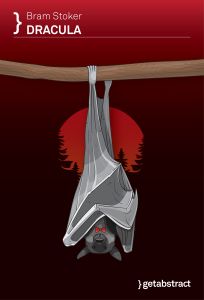
Dracula
- Gothic fiction
- Victorian literature
What It’s About
An Undead Tale Lives On
Dracula is a Gothic horror tale par excellence and a classic of the genre. It is an exemplary treatment of popular belief in the undead and introduces supernatural characters of terrifying evil. Author Bram Stoker based the story on folk tales and myths but placed it in his time of Victorian Britain – a time that elevated technical progress, empiricism and the scientific mind above all else. Stoker plays to these mainstays of Victorian society by writing his novel in the form of letters and diary extracts – contemporary, unerring, first-hand accounts. Despite this empirical approach, the story takes its readers on a tense journey into a world where reason and facts no longer apply. Dracula marks the starting point of the vampire’s triumphal procession into modern cinemas and popular culture. The various subtexts that pervade the novel – including eroticism and social criticism – further contribute to people’s fascination with the legend of the vampire.
Summary
About the Author
Abraham “Bram” Stoker was born on November 8, 1847, in the Dublin suburb of Clontarf in a family of seven children. His father was a civil servant and his mother a charity worker and writer. He spent the first seven years of his life bedbound due to some unidentifiable illness. During this time, his mother told him many stories, which, together with the enforced bed rest, probably contributed to his reflective nature and great imagination. He recovered by age eight and started going to school. He went on to win a prize for athleticism while studying at Trinity College in Dublin. In 1870, he started his career as a civil servant in Dublin’s administration of justice. In his spare time, he wrote theater reviews for the Dublin Evening Mail and also published his first short stories. In 1876, he met the famous British actor Henry Irving. Two years after their initial meeting, Irving offered Stoker the manager position at the Lyceum Theater in London, which Irving owned. Against the wishes of his parents, Stoker moved to London in 1878 to take on the position. There he also married actress and celebrated beauty Florence Balcombe. Stoker held the post of manager at the Lyceum until Irving’s death in 1905. He continued writing and in 1881 published Under the Sunset – a collection of short stories – followed by his first novel, The Snake’s Pass, in 1890. During this time, he started his initial work on Dracula. Yet even his most popular novel didn’t provide him with the means to become a full-time writer. A year after Irving’s death, in 1906, Stoker published a collection of memoirs of the actor. His last novel, The Lair of the White Worm, was published in 1911. He died on April 20, 1912, in London.







Comment on this summary